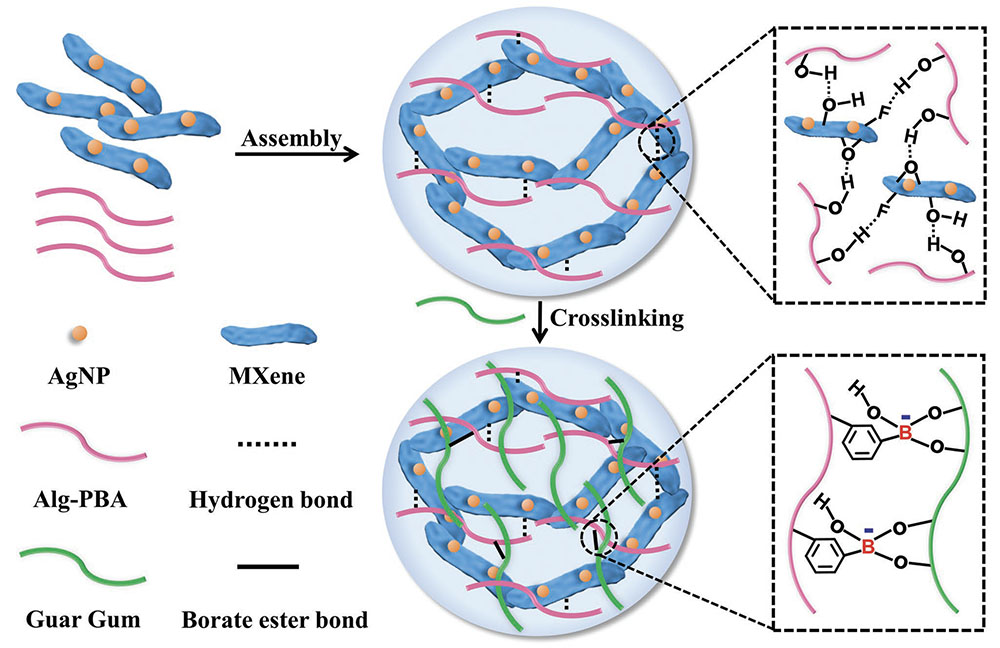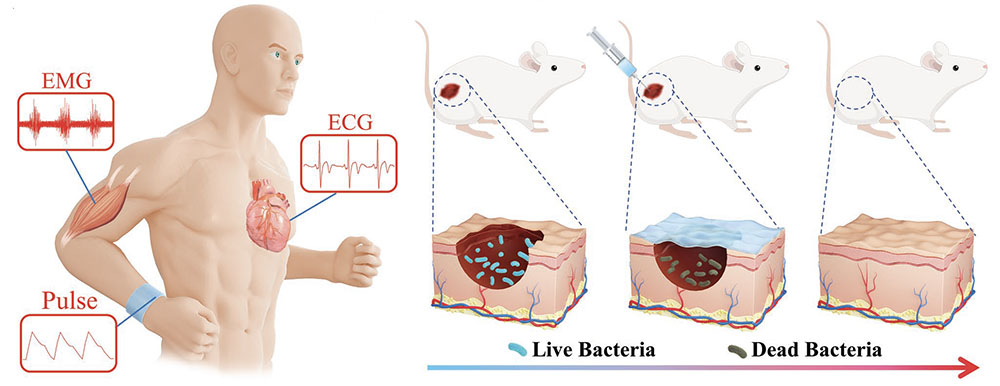| May 18, 2023 |
| |
|
(Nanowerk Spotlight) The field of wearable electronics has seen a surge of interest in the research and development of conductive hydrogels, largely due to their skin-like softness, structural resemblance to biological tissues, and tunable 3D conductive channels. These features make them particularly suitable for a variety of applications, such as wearable electronics, flexible energy storage systems, and smart medical treatments.
|
|
In the past decade, there has been a notable increase in the attention given to conductive hydrogel-based epidermic sensors. These sensors have the ability to convert physiological activity signals into detectable electronic signals, which is an incredibly useful feature for applications in flexible electronic skins, human-machine interfaces, and medical diagnoses.
|
|
However, the adoption of these sensors in practical applications has been limited by certain factors. These include their weak mechanical strength, low electrical conductivity, and subpar sensing performance. These limitations restrict the sensor’s capability to ultrasensitively monitor tiny electrophysiological signals like the electromyogram (EMG) signals and the electrocardiogram (ECG) signals, which are critical for rehabilitation training and the diagnosis of muscle- and cardiovascular-related diseases.
|
|
MXenes, 2D conductive transition-metal carbides and carbonitrides, have shown great promise in overcoming these limitations. Their negatively charged hydrophilic surfaces, large specific surface area, and high electrical conductivity make them excellent candidates for enhancing the mechanical properties, electrical conductivity, and sensing performances of conductive hydrogel epidermic sensors.
|
|
Consequently, the need to develop MXene hydrogel-based epidermic sensors is pressing, especially in monitoring human movements and tiny electrophysiological signals, with potential applications in rehabilitation training and the diagnosis of cardiovascular and muscle-related diseases.
|
 |
| Schematic of the fabrication of the healable, injectable, and antibacterial MXene hydrogel. (Reprinted with permission by Wiley-VCH Verlag)
|
|
Recent advancements in this field have seen the development of various conductive hydrogel-based flexible epidermic sensors for human healthcare monitoring. However, they lack the ability to provide efficient therapy capabilities, hindering their application in diagnostic healthcare sensing and timely therapy. One area of significant interest is wound treatment, as wounds can greatly increase the risk of infection, resulting in a deterioration of the wound condition, extended healing time, and in severe cases, mortality.
|
|
Functional hydrogel-based wound dressings offer a simple yet effective approach to wound treatment. Multifunctional hydrogels, equipped with self-healing capabilities, robust injectability, and excellent antibacterial activity, could be directly injected onto wound sites, providing protection against further infections and promoting efficient antibacterial and accelerated wound repair.
|
|
Research published in Advanced Functional Materials (“Flexible Accelerated-Wound-Healing Antibacterial MXene-Based Epidermic Sensor for Intelligent Wearable Human-Machine Interaction”) shows a significant advancement in the field with the creation of a healable, injectable, and antibacterial MXene hydrogel.
|
|
This hydrogel incorporates an antibacterial silver nanoparticles-coated MXene (AgNPs/MXene) nanosheets network into a polymer network of guar gum (GG) and phenylboronic acid grafted sodium alginate (Alg-PBA). The as-prepared MXene hydrogel exhibits enhanced mechanical strength, improved electrical conductivity, and strong antibacterial abilities.
|
 |
| Applications of the MXene hydrogel in human healthcare monitoring and wound therapy. (Reprinted with permission by Wiley-VCH Verlag)
|
|
The MXene hydrogel can be used as a multifunctional epidermic sensor that can monitor large human activities and tiny electrophysiological signals. It offers significant clinical information for rehabilitation training and cardiovascular and muscle-related diseases.
|
|
The hydrogel’s self-healing capability comes from the supramolecular interaction among AgNPs/MXene nanosheets, GG, and Alg-PBA, and the dynamic crosslinking between the hydroxyl groups of GG and the phenylboronic acid groups of Alg-PBA. The hydrogel also possesses robust injectability and good cytocompatibility. Its outstanding antibacterial properties are primarily derived from the AgNPs coated on the MXene nanosheets.
|
|
Most impressively, this MXene hydrogel can be directly injected onto wound sites for further antibacterial treatment and wound repair, effectively accelerating wound healing. This advancement opens up new possibilities in the fabrication of flexible conductive hydrogel-based epidermic sensors that integrate high-performance sensing capabilities for potential diagnosis and treatment.
|
|
This development has tremendous potential in wearable electronics, health diagnosis, and smart medical treatment, marking a significant step forward in the field of wearable human-machine interaction.
|

By
Michael
Berger
– Michael is author of three books by the Royal Society of Chemistry:
Nano-Society: Pushing the Boundaries of Technology,
Nanotechnology: The Future is Tiny and
Nanoengineering: The Skills and Tools Making Technology Invisible
Copyright ©
Nanowerk LLC
|
|
|
- SEO Powered Content & PR Distribution. Get Amplified Today.
- PlatoAiStream. Web3 Data Intelligence. Knowledge Amplified. Access Here.
- Minting the Future w Adryenn Ashley. Access Here.
- Buy and Sell Shares in PRE-IPO Companies with PREIPO®. Access Here.
- Source: https://www.nanowerk.com/spotlight/spotid=63018.php






